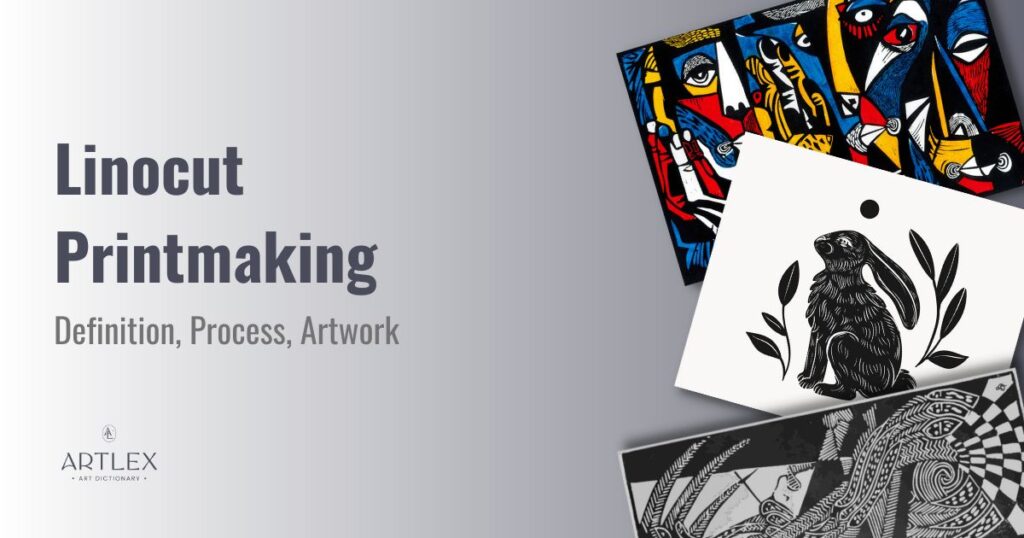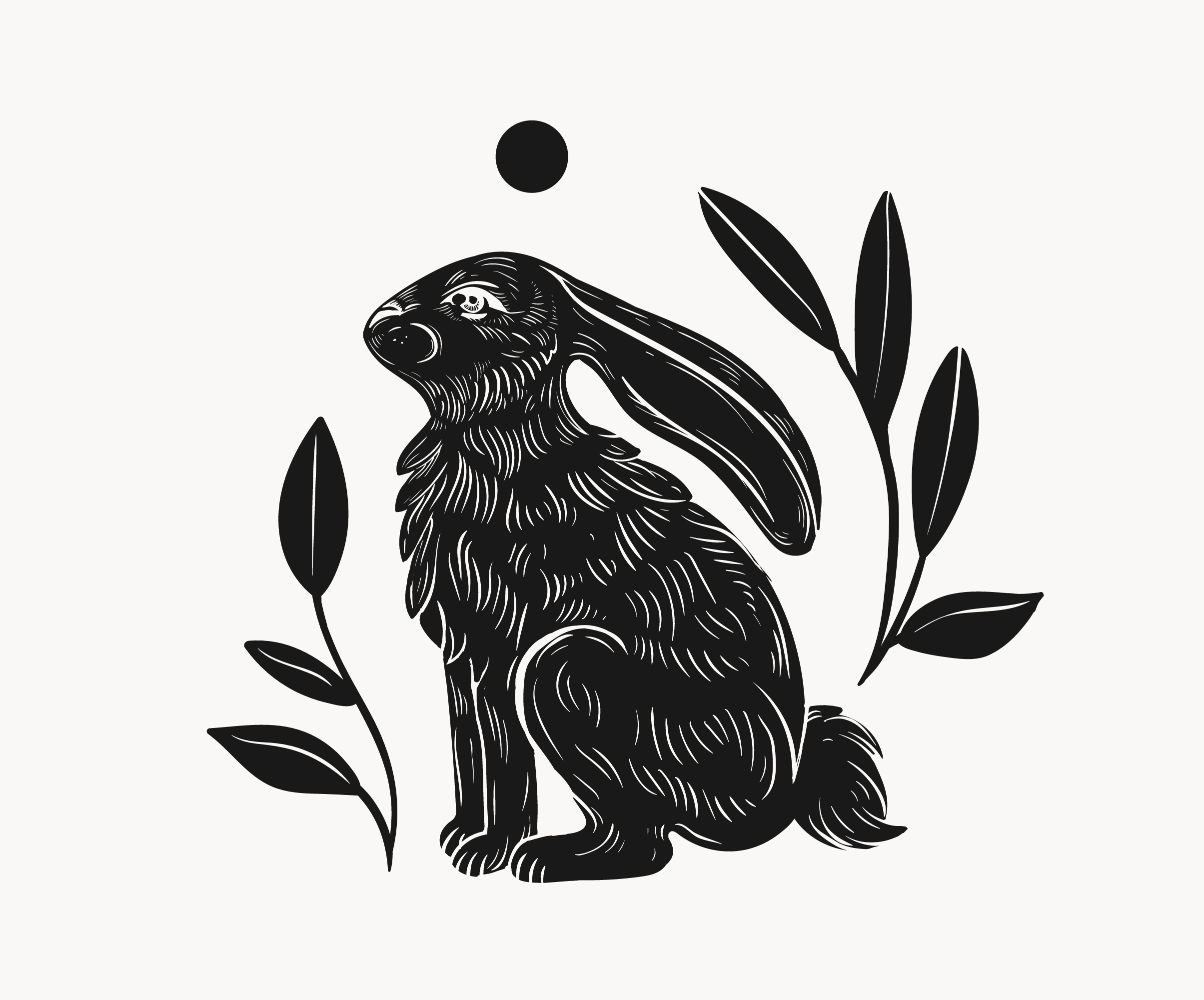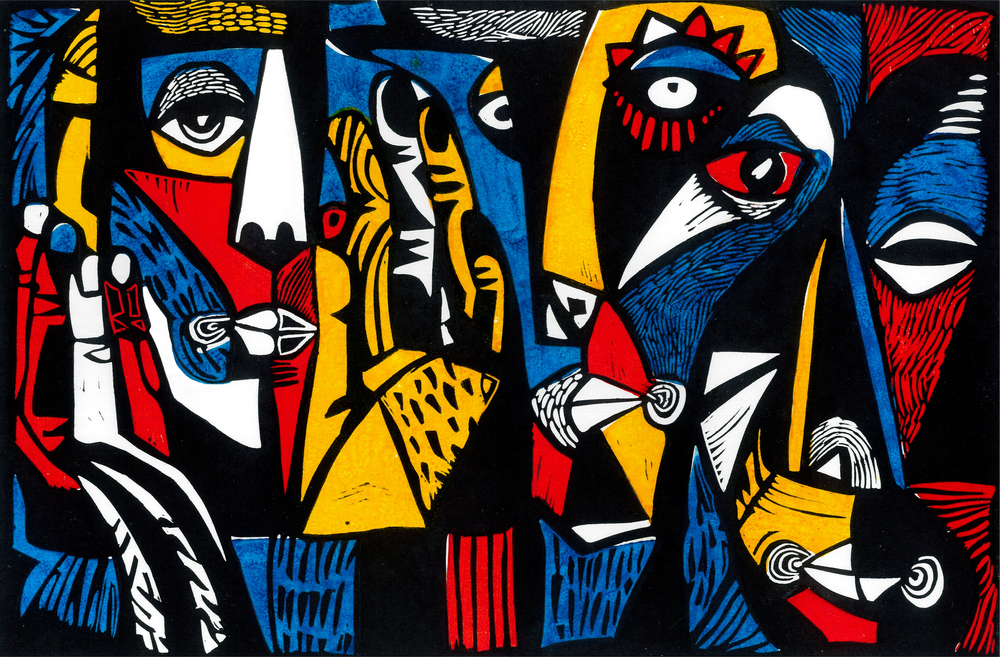
There are several types of media artists can use to create reliefs or block prints for use in creating art. While some media are classics, such as wood and metal, one media only has about one hundred years of history behind it: linocut printmaking.
What is linocut printmaking? How does this printmaking process differ from the other, more classic options? Let’s look at how this printmaking technique stands out from the others and how new artists can delve into this practice themselves.
What is Linocut Printmaking?
Linocut printmaking is a form of printmaking art where artists cut a printing plate out of linoleum. This linoleum is the same material used for floor coverings. Artists will cut patterns and shapes out of the linoleum before inking the synthetic rubber and running the print through a printing press to transfer the print pattern onto paper.
As this art requires the use of linoleum, linocut printmaking didn’t exist before the product’s creation in 1860. British rubber manufacturer Fredrick Walton created linoleum as a cheaper alternative to rubber. By heating linseed oil in thin layers and connecting those layers with a mesh framework, Walton created linoleum.

Why Use Linoleum Over Other Materials for Prints?
Linoleum has two advantages over other print media like wood and metal: cost and ease of use.
Generally speaking, linoleum is easier to make than the high-quality wood or metal necessary for creating prints. This lower cost for the printing medium means that more artists can afford to create prints using linoleum.
Also, linoleum is more forgiving than metal and wood. If an artist makes a mistake with linoleum, they can reheat the linoleum and smooth out the mistake. Wood cannot be fixed once carved, and metal plates require high temperatures to fix mistakes than linoleum or rubber.
What Tools Do You Need to Make Linocut Prints?
The tools needed for lino printing are similar to those for other printed arts. Most lino printing artists will have these tools, though:
- Pencils: Pencils are great for creating an initial sketch for a design
- Marker Pen: Once an artist has their initial design set, going over the sketch with a marker will prevent the pencil lines from rubbing off during the printing process
- Carbon paper: Carbon paper could help you transfer your design onto the lino, though it isn’t always necessary
- Tracing paper: Tracing your design onto tracing paper allows you to flip the design back to front, ensuring the correct design orientation goes onto the lino block
- Linoleum: Since this is the material you make the print on, having linoleum is critical for the lino printing process
- Carving tools: Lino printing artists will use both U-shaped gouges and V-shaped cutters as lino cutting tools to create their pattern on the linoleum
- Sharpening tools: Since the carving tools can wear out with use, having tools to resharpen them will help with upkeep and overall efficiency
- Printing ink: There are several printing ink types that an artist can use, including water-based inks, oil-based inks, and others. Each printing ink type has a different application in lino printing
- Inking slabs: These slabs help artists put an even film of ink on their rollers before applying the roller to the linocut
- Roller/brayer: Similar to a paint roller, this tool applies an even layer of ink to the linoleum print
- Printing press or baren: Either of these tools allows a lino printing artist to transfer their print from the inked linoleum to paper via their smooth surface. Some artists also use a wooden spoon as their baren.
- Printmaking paper: Printing paper receives the ink from the linocut and is the final product of the lino printing process
Choosing the Best Paper for Linocuts
There is no universal printing paper choice for lino printing. Artists will consider different types of paper depending on several elements and how they relate to the print in question:
- Weight: Measured in grams per square meter (GSM), thin paper and lighter weight paper are best for hand-pressed prints, while heavier papers work well for prints made with a printing press
- Acidity: Acid-free paper will not leech ink over time like acidic paper will, making neutral pH paper necessary for creating lasting linocut prints
- Color: Papers range in color from white to tan, with noticeable differences between paper types of the same color
- Size: Matching the size of your paper pad or roll to your printing option is important for reducing waste
- Texture: Different papers have different grain structures, meaning the print will look different on smooth paper compared to rough paper
Experimenting with different papers is the best practice a new linocut printmaker can take. Many linocut artists prefer a low-weight and acid-free white paper, but most any paper compatible with a printing press will work for lino printing.
The History of Linocut Printmaking

The start of artists using linocuts for prints isn’t well documented. While the initial uses of linoleum involved wallpapering and floorings, artists didn’t seem to experiment with the medium until the 1890s, roughly 30 years after the invention of the material.
The first artists that did experiment with lino block prints were those familiar with relief printmaking. Painters and woodblock printers used linoleum as a way to create reliefs without relying on wood, a much more difficult medium to carve. Examples of these early reliefs come from as early as the year 1895.
Over the next few decades, artists began to understand and appreciate the differences between linoleum and other relief print media. Books began to come out explaining how artists could use linoleum as a print medium and what techniques seemed to work best.
Because of its forgiving nature, linoleum was a print medium associated with students and amateurs. The idea was that because linoleum was a more forgiving medium that allowed for mistakes to be corrected, lino block printing was where artists would learn printing techniques before switching to other, more professional media.
This perception changed over time, mostly due to acceptance by the art community. Some big names in art, including Pablo Picasso, created works using linocut printmaking, which no doubt helped improve the art community’s perception of the craft.
Types of Lino Prints
While there are several types of lin prints artists can make, they mostly fall into two categories: single-color linocuts and reduction linocuts.
Single Color Linocuts
Single-color linocuts are prints made using a lino plate and a single color of ink. This linocut is the easiest to make as the process requires the artist to cut their lino block once and apply ink only once. Most artists use black ink for these prints due to their high contrast with white paper, making the print easy to see.
The creation of single-color linocuts involves the carving of the linoleum to create voids for the ink to go into. Thus, when the ink goes onto the print, the cuts in the linoleum will show up as white spaces, compared to the black ink from the remaining flat surfaces.
Reduction Linocuts
Reduction linocuts create multi-colored prints by cutting a lino block again and again for each new color added to the print. Artists creating a reduction linocut have to carve the linoleum again for each new color they want to add to their print.
The first cut for the linoleum sets the black-and-white spaces on the initial print. From there, artists plan and cut the lino block again to add a new color of ink to the print. The new carving goes onto the original print, essentially overlaying the new color layer onto the old print. The artist then repeats this process for each new color they want to add, though each new layer adds another layer of complexity and planning to the overall piece.
How to Make a Linocut Print
With the history and background of lino printing covered, let’s go over the process many artists follow when they craft their lino cut:
Fitting Blades For Your Linocut Tools
Though the carving tools used in lino cut creation might seem complicated, fitting your tools is straightforward. Most carving tools have interchangeable blades with a sharp carving end and a metal stem that fits into the wooden handles of the carving tool.
To fit the carving edge, unscrew the end of the handle where the blade goes. Hold the blade between your fingers, away from the sharp carving edge, and carefully insert the blade into the handle. If it doesn’t go in easily, unscrew the handle a little more to create more space. Forcing the blade can cause you to cut yourself.
Create A Design Sketch
Before creating your first linocut, it is best to do a practice sketch using pencil and paper to create a design you like. You can also draw directly onto the linoleum if you prefer, though sketching on paper has its own merits.
For example, sketching on paper gives you an easy way to see if a design will work or not.
Sketching on paper and then transferring that sketch to tracing paper would allow you to create a mirror image as well. A mirror image for your design is essential for designs with text, as the text appearing backward on your lino block will result in the text facing the right after you ink onto the paper.
Make Your Initial Carves
With your design ready, take your cut lino sheet and place it into a bench hook to keep it secure while you carve the linoleum. Applying pressure with the sharp lino-cutting tools, start the linocut process by following your sketch or design drawn onto the linoleum as needed.
Utilizing different shapes and lino-cutting tools, you will create your linocut design by carving out sections of the linoleum. Fine detail will come with time and practice, so don’t feel bad if your linocut design feels simplistic at first.
If you make a mistake, you can use glue or putty to add the linoleum back into place and try again.
Ink the Linoleum Sheet
The next step to create your lino print is to roll ink onto the lino. Using a roller, apply ink evenly using an inking slab and rolling a thin layer of ink onto the roller.
Once your roller has ink, transfer it over to your lino block and roll the ink onto the roller. Ensure that you apply pressure evenly to the inked block so that the thin layer of ink covers the lino and is evenly distributed.
Don’t be afraid to use more ink if you don’t apply enough with the roller at first. While you shouldn’t go overboard with the ink, different inks spread out differently depending on what they are made out of. If your ink stays as a thick layer, you might need more ink to cover the lino.
Print the Linocut
With the ink applied to the linoleum cut, you can transfer the image to paper. Place the inked lino into a printing press with paper. The printing press will apply pressure to the paper and inked lino, creating your print.
If you use a baren instead, you will place the paper on top of the inked lino. Place the baren on top of the paper and apply even pressure with your arm. The pressure applied to the paper and lino with the baren will transfer the image to the paper, creating your print.
Some artists use a wooden spoon in place of a baren, applying even pressure as they drag the spoon along the paper.
Practice Different Styles and Techniques to Improve
Different artists create different styles of lino prints. The process of lino block printing allows an artist to create different works between the different inks, designs, cutting tools, and ink application techniques an artist can do to create their final print.
Overall, the best way to grow as an artist is to inspire yourself with designs from other lino print artists. See how these artists create the works and what about their designs has allowed them to stand the test of time.
How to Stay Safe While Making a Linocut Print
As mentioned, lino block carving requires the use of sharp tools to make your lino prints. This means that artists will need to take some safety precautions when working with their lino carving tools to mitigate the chances of a serious injury.
Some of the best tips for staying safe with these tools are:
- Always cut away from you so that, if your hand slips, you dig into the linoleum and not yourself.
- Keep track of where your fingers are at all times, and if they would be in the path of a carve you are about to do with your tools
- Have some antiseptic and some bandages nearby in case you cut yourself
- Keep the sharp tools away from children and pets who might get curious about the shiny metal on the tools
- Don’t hesitate to go to a clinic if you receive a deep cut from one of the carving tools.
Popular Linocut Print Artists to Get Inspired By
Part of growing as n artist involves looking to those who found success with the craft as a source of inspiration. Looking to those that came before you can help you learn techniques, designs, and messages that resonate with audiences.
Below are some of the most popular linocut print artists we think are a great place to start for most beginner artists:
Pablo Picasso

One of the most influential artists of the 20th century, Pablo Picasso, dabbled in all sorts of art styles and media. One of those media was linocut printing. Picasso used the medium sparingly but created great works with linocuts during his art career.
His works featured people in stylized manners, lending to his experimental preferences. While Picasso’s greatness lies in what was experimental back then, his works are a great reminder to play with one’s creativity and envision something everyone knows in a different light.
Valenti Angelo
Despite being an author and illustrator, Valenti Angelo also found time to create linocuts of his own. While not as stylized as the works of Picasso, Angelo created realistic designs using reduction linocut practices.
Drawing inspiration from Angelo, one could see how creating the likeness of something with linoleum and ink would be beautiful.
Georgy Kovenchuk
Georgy Kovenchuk is a Russian illustrator and printmaker who created designs across most forms of printmaking media during his time. He maintains high accolades in the Russian art world thanks to his efforts in book illustration and print crafting.
Kovenchuk’s linocuts are simplistic in their approach. Though not stylized or dramatic in their appearance, Kovenchuk’s linocuts are a display of how simplicity can communicate your message as well as something fanciful.
Karl Schmidt-Rottluff
Karl Schmidty-Rottluff is one of the founders of the art group Die Brücke, a German Expressionist artist group that preferred simplistic art that stayed grounded in some amount of physical reality.
Schmidt-Rottluff’s linocuts represent this stylistic choice in their shape. While the linocuts he produced depicted people and places, the lines and shapes used to craft these people reflect an abstraction that differs from older artists.
Torsten Billman
Though Torsten Billman is one of the premier wood engravers of the 20th century, the printmaker experimented with linocuts, too. These linocuts were illustrations meant to go with Upton Sinclair’s novel Jimmie Higgins, but they never made it to the market.
The linocuts feature nautical scenes and sailors. The line work on these designs captures the motion of the waves simply and clearly, making it clear that these illustrations conveyed some part of the story and had book printers in mind with their creation.
Linocut Printmaking FAQs
Here are answers to some of the other common questions out there about linocut printing:
What is special about linocut?
Linocut prints use linoleum as the printing medium compared to typeset printing or woodcut prints. Linocut printing offers a more forgiving medium to work with and allows for a broader range of effects compared to woodcut due to the lack of a grain structure in linoleum.
Is lino ink toxic?
Most lino ink is non-toxic, especially the water-based ink available today. Artists should still be careful when working with linocut inks, though, as the inks can stain the clothes and skin if not properly washed out.
Can you lino print without a roller?
A roller isn’t necessary to transfer your inked linocut pattern to paper. Traditional printing methods from Japan use a baren instead of a printing press with rollers. A baren is a smooth, flat surface with a handle that allows the printer to deliver even pressure to the print during the transfer of ink to paper.
Why is linocut criticized?
When it was first developed as an art medium, many artists criticized artists using linoleum and linocut techniques due to the ease of use linoleum offered over metal and wood. Because artists could correct mistakes, many traditional artists saw linoleum as a lesser medium.
Is lino printing sustainable?
Despite its synthetic nature, linoleum is a sustainable material. Most modern linoleums use linseed oil, sawdust, rosins, and limestone for their raw materials, which break down readily in composting bins and landfills. Thus, many linoleums are safe for the environment.
Summary
Linocut printmaking is a way to create prints using a medium some artists believe is easier than wood or metal. Despite the perceptions surrounding linocut printmaking as an amateur practice, many renowned artists have used or experimented with the medium to create beautiful works of art.
Getting into linocut printmaking requires special tools, unlike other art forms like painting or sketching. However, the process is rewarding and allows an artist to create multiple copies of their work as long as they keep the original lino cut.
